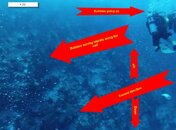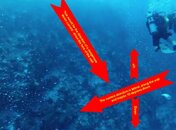Mike
Contributor
Watch the video between 4:15-4:45 everything you need to know happens in those 30 seconds.
The current is clearly visible as a strong LATERAL current. Watch the bubbles. There are small bubbles coming at the camera divers face, bubbles run with the current and No Bubbles are going down anywhere in the video.
At 4:22 you hear the camera diver for the very first time put air in his BCD.
All this is, is a diver way to aggressive, coupled with ignoring diver buddy training, couple with a buddy ignoring diver buddy training. I'm sure they've been diving this way for a long time and as is the case with diving, you can break the rules a long time until 1 condition changes the equation and it all catches up with you.
The camera diver dropped like a rock to the wall, he didn't even think to start adding air to his BCD untill 4:22, at which point he was feeling the current running at him and downward along the wall face, he only puts in a couple of puffs of air, you can hear them in the video, two quick puffs, he's using his legs and fins instead to compensate and he's feeling the current continue to pull him down, at 4:30 he starts to panic, you can see the difference in his breathing, you start seeing big bubbles coming up out of his exhales, he's still trying to use his legs and fins against the current and it takes him until 4:45 to put 3 larger puffs in his BCD. It's taken him until 4:45 to achieve neutral buoyancy, where he should have been back closer to 3:50. The video is scary to watch because you feel for the panic of the camera diver, but this is just poor diving habits catching up to somebody.
The current is clearly visible as a strong LATERAL current. Watch the bubbles. There are small bubbles coming at the camera divers face, bubbles run with the current and No Bubbles are going down anywhere in the video.
At 4:22 you hear the camera diver for the very first time put air in his BCD.
All this is, is a diver way to aggressive, coupled with ignoring diver buddy training, couple with a buddy ignoring diver buddy training. I'm sure they've been diving this way for a long time and as is the case with diving, you can break the rules a long time until 1 condition changes the equation and it all catches up with you.
The camera diver dropped like a rock to the wall, he didn't even think to start adding air to his BCD untill 4:22, at which point he was feeling the current running at him and downward along the wall face, he only puts in a couple of puffs of air, you can hear them in the video, two quick puffs, he's using his legs and fins instead to compensate and he's feeling the current continue to pull him down, at 4:30 he starts to panic, you can see the difference in his breathing, you start seeing big bubbles coming up out of his exhales, he's still trying to use his legs and fins against the current and it takes him until 4:45 to put 3 larger puffs in his BCD. It's taken him until 4:45 to achieve neutral buoyancy, where he should have been back closer to 3:50. The video is scary to watch because you feel for the panic of the camera diver, but this is just poor diving habits catching up to somebody.






